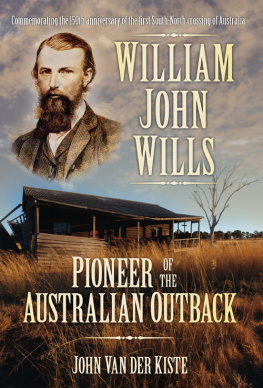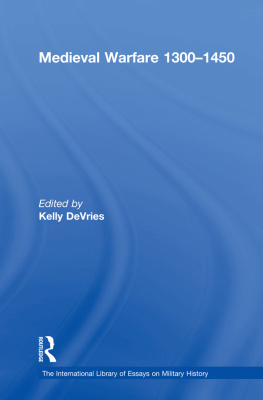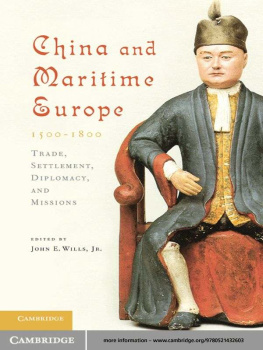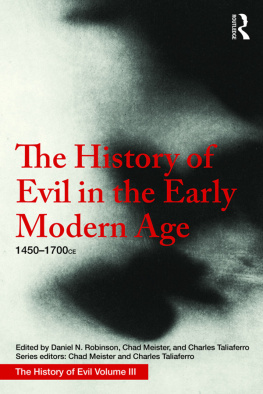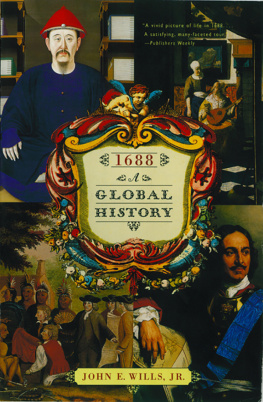Wills John E. - The World from 1450 To 1700
Here you can read online Wills John E. - The World from 1450 To 1700 full text of the book (entire story) in english for free. Download pdf and epub, get meaning, cover and reviews about this ebook. year: 2009, publisher: Oxford University Press USA - OSO, genre: History. Description of the work, (preface) as well as reviews are available. Best literature library LitArk.com created for fans of good reading and offers a wide selection of genres:
Romance novel
Science fiction
Adventure
Detective
Science
History
Home and family
Prose
Art
Politics
Computer
Non-fiction
Religion
Business
Children
Humor
Choose a favorite category and find really read worthwhile books. Enjoy immersion in the world of imagination, feel the emotions of the characters or learn something new for yourself, make an fascinating discovery.

- Book:The World from 1450 To 1700
- Author:
- Publisher:Oxford University Press USA - OSO
- Genre:
- Year:2009
- Rating:3 / 5
- Favourites:Add to favourites
- Your mark:
- 60
- 1
- 2
- 3
- 4
- 5
The World from 1450 To 1700: summary, description and annotation
We offer to read an annotation, description, summary or preface (depends on what the author of the book "The World from 1450 To 1700" wrote himself). If you haven't found the necessary information about the book — write in the comments, we will try to find it.
The World from 1450 To 1700 — read online for free the complete book (whole text) full work
Below is the text of the book, divided by pages. System saving the place of the last page read, allows you to conveniently read the book "The World from 1450 To 1700" online for free, without having to search again every time where you left off. Put a bookmark, and you can go to the page where you finished reading at any time.
Font size:
Interval:
Bookmark:
The World from 1450 to 1700


John E. Wills Jr.


Oxford University Press, Inc., publishes works that further Oxford Universitys objective of excellence in research, scholarship, and education.
Oxford New York
Auckland Cape Town Dar es Salaam Hong Kong Karachi Kuala Lumpur Madrid Melbourne Mexico City Nairobi New Delhi Shanghai Taipei Toronto
With offices in
Argentina Austria Brazil Chile Czech Republic France Greece Guatemala Hungary Italy Japan Poland Portugal Singapore South Korea Switzerland Thailand Turkey Ukraine Vietnam
Copyright 2009 by Oxford University Press, Inc.
Published by Oxford University Press, Inc.
198 Madison Avenue, New York, NY 10016
www.oup.com
Oxford is a registered trademark of Oxford University Press.
All rights reserved. No part of this publication may be reproduced, stored in a retrieval system, or transmitted, in any form or by any means, electronic, mechanical, photocopying, recording, or otherwise, without the prior permission of Oxford University Press.
Library of Congress Cataloging-in-Publication Data
Wills, John E. (John Elliot), 1936
The world from 1450 to 1700 / John E. Wills, Jr.
p. cm.
Includes index.
Summary: Traces the interwoven changes that led from the world of
Columbus, Luther, and the Mughal emperor Babur to the world of
Locke, Louis XIV, and the Kangxi Emperor. Wills encourages his readers
to acknowledge the special features of the European experience and
achievement without presenting Europe as essentially the only source of
the modern.Provided by publisher.
ISBN 978-0-19-533797-6 (pbk.)ISBN 978-0-19-516517-3 (hardcover)
1. History, Modern. 2. EuropeHistory. I. Title.
D228.W53 2009
909.08dc22
2009005806
1 3 5 7 9 8 6 4 2
Printed in the United States of America
on acid-free paper
Frontispiece: Armillary of the world, 18th century.
Library of Congress, LC-USZ62-87905.
To my colleagues at the University
of Southern California
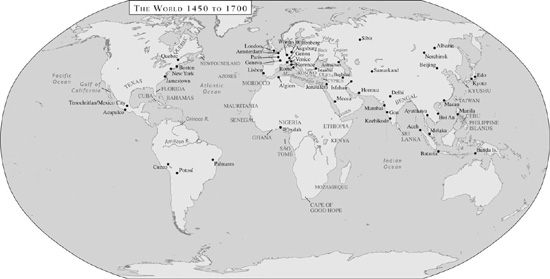
This book is part of the New Oxford World History, an innovative series that offers readers an informed, lively, and up-to-date history of the world and its people that represents a significant change from the old world history. Only a few years ago, world history generally amounted to a history of the WestEurope and the United Stateswith small amounts of information about the rest of the world. Some versions of the old world history drew attention to every part of the world except Europe and the United States. Readers of that kind of world history might get the impression that somehow the rest of the world was made up of exotic people who had strange customs and spoke difficult languages. Still another kind of old world history presented the story of areas or peoples of the world by focusing primarily on the achievements of great civilizations. Readers learned of great buildings, influential world religions, and mighty rulers but little of ordinary people or more general economic and social patterns. Interactions among the worlds peoples were often told from only one perspective.
This series has a different perspective on world history. First, it is comprehensive, covering all countries and regions of the world and investigating the total human experienceeven those of so-called peoples without histories living far from the great civilizations. New world historians thus share an interest in all of human history, even going back millions of years before there were written human records. A few new world histories even extend their focus to the entire universe, a big history perspective that dramatically shifts the beginning of the story back to the Big Bang. Some see the new global framework of world history today in terms of viewing the world from the vantage point of the moon, as one scholar put it. We agree. But we also want to take a close-up view, analyzing and reconstructing the significant experiences of all of humanity.
This is not to say that everything that has happened everywhere and in all time periods can be recovered or is worth knowing, but that there is much to be gained by considering both the separate and interrelated stories of different societies and cultures. Making these connections is still another crucial ingredient of the new world history. It emphasizes connectedness and interactions of all kindscultural, economic, political, religious, and socialinvolving peoples, places, and processes. It makes comparisons and finds similarities. Emphasizing both the comparisons and interactions is critical to developing a global framework that can deepen and broaden historical understanding, whether the focus is on a specific country or region or on the whole world.
The rise of the new world history as a discipline comes at an opportune time. The interest in world history in schools and among the general public is vast. We travel to one anothers nations, converse and work with people around the world, and are changed by global events. War and peace affect populations worldwide as do economic conditions and the state of our environment, communications, and health and medicine. The New Oxford World History presents local histories in a global context and provides an overview of world events seen through the eyes of ordinary people. This combination of the local and the global further defines the new world history. Understanding the workings of global and local conditions in the past enables us to examine our own world and to envision the interconnected future that is in the making.
Bonnie G. Smith
Anand Yang
The World from 1450 to 1700
On June 17, 1527, a squadron of five ships with about six hundred men aboard set out from the port of San Lucar de Barrameda in southern Spain. The commander, Pmphilo de Narvez, had a royal commission to conquer and govern lands along the north side of the Gulf of Mexico from the peninsula that now is Florida to about the Texas-Mexico border. Other Spaniards were named to lesser offices in the planned colony, and there were several Franciscan priests on board. There is no evidence that the Native American inhabitants of these lands would have any say as to who ruled them. The pope had divided the world between the Spanish and the Portuguese monarchies. Most Roman Catholics believed that the pope was Gods deputy on earth, the head of the one true church. Charles V, King of Spain and Holy Roman Emperor, was just beginning his long years of bitter struggle against the challenges to Catholicism of Martin Luther and his followers. Anyone on the voyage over thirty-five had been born in a Spain still at war with a Muslim monarchy in its midst, at Granada, and the tensions between Spanish Catholics and Spaniards of Muslim and of Jewish heritage gave an unusually militant character to Spanish Catholicism. Piracy and slave-raiding across the Mediterranean, between its Catholic northern and Muslim southern shores, also shaped peoples attitudes. Some of the leaders of the expedition brought an African slave or two along to serve them.
Next pageFont size:
Interval:
Bookmark:
Similar books «The World from 1450 To 1700»
Look at similar books to The World from 1450 To 1700. We have selected literature similar in name and meaning in the hope of providing readers with more options to find new, interesting, not yet read works.
Discussion, reviews of the book The World from 1450 To 1700 and just readers' own opinions. Leave your comments, write what you think about the work, its meaning or the main characters. Specify what exactly you liked and what you didn't like, and why you think so.

